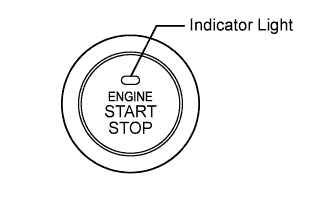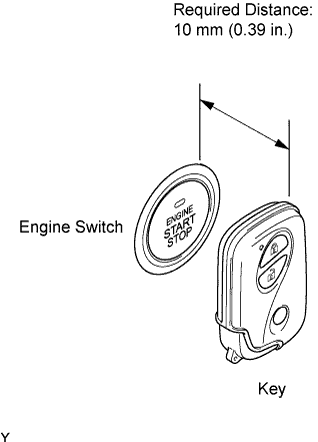Lexus IS250 IS220d GSE20 ALE20 2AD-FHV STARTING
ENTRY AND START SYSTEM - SYSTEM DESCRIPTION
| PUSH-BUTTON START FUNCTION DESCRIPTION |
The push-button start function uses a push-type engine switch, which the driver can operate by merely carrying the electrical key. This system consists primarily of the power source control ECU, engine switch, ID code box, steering lock ECU, electrical key, ACC relay, IG1 relay, IG2 relay and certification ECU. The power source control ECU controls the function. This function operates in cooperation with the entry and start system.
| FUNCTION OF COMPONENT |
| Components | Function |
| Engine Switch Transponder Key Amplifier | Transmits engine switch signal to power source control ECU. Informs driver of a power source mode or system abnormality with illumination stage of indicator light. Receives ID code and transmits it to certification ECU when the key battery is low. |
| Electrical Key | Receives signals from oscillators and returns ID code to entry door control receiver. |
| Electrical Key Oscillator Console and Rear Seat | Receives request signals from certification ECU and forms detection area in vehicle interior. |
| Entry Door Control Receiver | Receives ID code from electrical key and transmits it to the certification ECU. |
| Power Source Control ECU | Changes power source mode in 4 stages (off, on (ACC), on (IG), start) in accordance with state of clutch switch and key ID matches vehicle. Controls push-button start function in accordance with signals received from switches and each ECU. |
| Certification ECU | Certifies the ID code received from entry door control receiver and transmits certification results to the ID code ECU and steering lock ECU. |
| ID Code Box | Receives steering unlock or engine immobiliser unset signals from certification ECU, certifies them, and transmits each unset signal to steering lock ECU or ECM. |
| ECM | Receives engine start request signal from power source control ECU, turns ON ST relay, and starts engine. Receives signal from ID code ECU and performs engine ignition and injection. |
| CONSTRUCTION AND OPERATION |

Engine Switch
The engine switch consists of a momentary type switch, 3 color (amber, green, greenish white) LEDs, and a transponder key amplifier.
Indicator Light Condition
| Power Source Mode/Condition | Indicator Light Condition | |
| Clutch pedal released | Clutch pedal depressed | |
| off | OFF | Turns ON (Green) (Key ID matches vehicle) |
| on (ACC, IG) | Turns ON (Amber) | Turns ON (Green) |
| Engine running | OFF | OFF |
| Steering lock not unlocked | Flashes (Green) for 30 sec. | Flashes (Green) for 30 sec. |
| System malfunction | Flashes (Amber) for 15 sec. | Flashes (Amber) for 15 sec. |
| Clutch start switch malfunction | Flashes (Green) for 15 sec. | Flashes (Green) for 15 sec. |
Power Source Control ECU
The power Source Control ECU consists of the ACC, IG1 and IG2 relay actuation circuits and CPU.
- HINT:
- Before removing the battery, make sure to turn the engine switch off. The power source control ECU constantly stores the present power source mode in its memory. Therefore, if the power source control ECU is interrupted by disconnecting the battery, the power source control ECU restores the power source mode after the battery is reconnected. For this reason, if the battery is disconnected when the engine switch is other than off, the power will be restored to the vehicle at the same time the power is restored to the power source control ECU (by reconnecting the battery).
| PUSH-BUTTON START FUNCTION OPERATION |
Start function has different power source patterns to suit the clutch pedal condition.
| Clutch Pedal | Power Source Mode Pattern |
| Depressed | When the engine switch is pushed once. off → engine start on (ACC) → engine start on (IG) → engine start |
| Not depressed | Each time the engine switch is pushed. off → on (ACC) → on (IG) → off |
| - | When the engine switch is pushed in the on (IG) condition (engine running). on (IG) → off |
When the battery of the key is low, the push-button start function can be operated by holding the key against the engine switch.
Transition of power source mode:

- HINT:
- While the vehicle is being driven normally, operation of the engine switch is disabled. However, if the engine must be stopped in an emergency while the vehicle is being driven, pressing the engine switch for 3 seconds or more stops the engine. Power source mode changes from engine start to on (ACC).
| WHEN KEY BATTERY IS LOW |

To operate the push-button start function when the key battery is low, hold the key close to the engine switch with the clutch pedal depressed.
The power source control ECU transmits a key verification request signal to the certification ECU.
The certification ECU does not receive an ID code response from the entry door control receiver, so it actuates the transponder key amplifier built into the engine switch.
The transponder key amplifier outputs an engine immobiliser radio wave to the key.
The key receives the radio wave, and returns a radio wave response to the transponder key amplifier.
The transponder key amplifier combines the key ID codes with the radio wave response, and transmits it to the certification ECU.
The certification ECU judges and verifies the ID code, and transmits a key verification OK signal to the power source control ECU. The buzzer in the combination meter sounds at the same time.
After the buzzer sounds, if the engine switch is pressed within 5 seconds with the clutch pedal not depressed, the power source mode changes to on (ACC) or on (IG), the same as in the normal condition.
| DIAGNOSIS |
The power source control ECU can detect malfunctions in the push-button start function when the power source mode is on (IG).
When the ECU detects a malfunction, the amber indicator light of the engine switch flashes to warn the driver. At the same time, the ECU stores a 5-digit DTC (Diagnostic Trouble Code) in the memory.